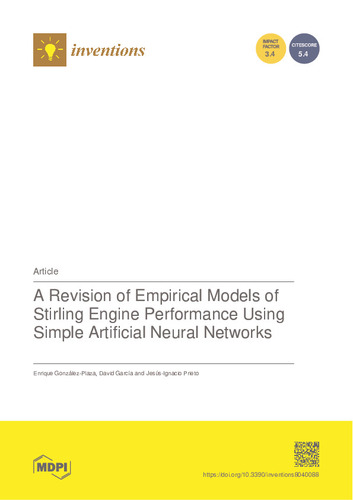A Revision of Empirical Models of Stirling Engine Performance Using Simple Artificial Neural Networks
Autor(es) y otros:
Palabra(s) clave:
Stirling engine
preliminary design
power correlations
engine speed correlations
ANN
Fecha de publicación:
Editorial:
MDPI
Versión del editor:
Citación:
Resumen:
Stirling engines are currently of interest due to their adaptability to a wide range of energy sources. Since simple tools are needed to guide the sizing of prototypes in preliminary studies, this paper proposes two groups of simple models to estimate the maximum power in Stirling engines with a kinematic drive mechanism. The models are based on regression or ANN techniques, using data from 34 engines over a wide range of operating conditions. To facilitate the generalisation and interpretation of results, all models are expressed by dimensionless variables. The first group models use three input variables and 23 data points for correlation construction or training purposes, while another 66 data points are used for testing. Models in the second group use eight inputs and 18 data points for correlation construction or training, while another 36 data points are used for testing. The three-input models provide estimations of the maximum brake power with an acceptable accuracy for feasibility studies. Using three-input models, the predictions of the maximum indicated power are very accurate, while those of the maximum brake power are less accurate, but acceptable for the preliminary design stage. In general, the best results are achieved with ANN models, although they only employ one hidden layer.
Stirling engines are currently of interest due to their adaptability to a wide range of energy sources. Since simple tools are needed to guide the sizing of prototypes in preliminary studies, this paper proposes two groups of simple models to estimate the maximum power in Stirling engines with a kinematic drive mechanism. The models are based on regression or ANN techniques, using data from 34 engines over a wide range of operating conditions. To facilitate the generalisation and interpretation of results, all models are expressed by dimensionless variables. The first group models use three input variables and 23 data points for correlation construction or training purposes, while another 66 data points are used for testing. Models in the second group use eight inputs and 18 data points for correlation construction or training, while another 36 data points are used for testing. The three-input models provide estimations of the maximum brake power with an acceptable accuracy for feasibility studies. Using three-input models, the predictions of the maximum indicated power are very accurate, while those of the maximum brake power are less accurate, but acceptable for the preliminary design stage. In general, the best results are achieved with ANN models, although they only employ one hidden layer.
ISSN:
Ficheros en el ítem





